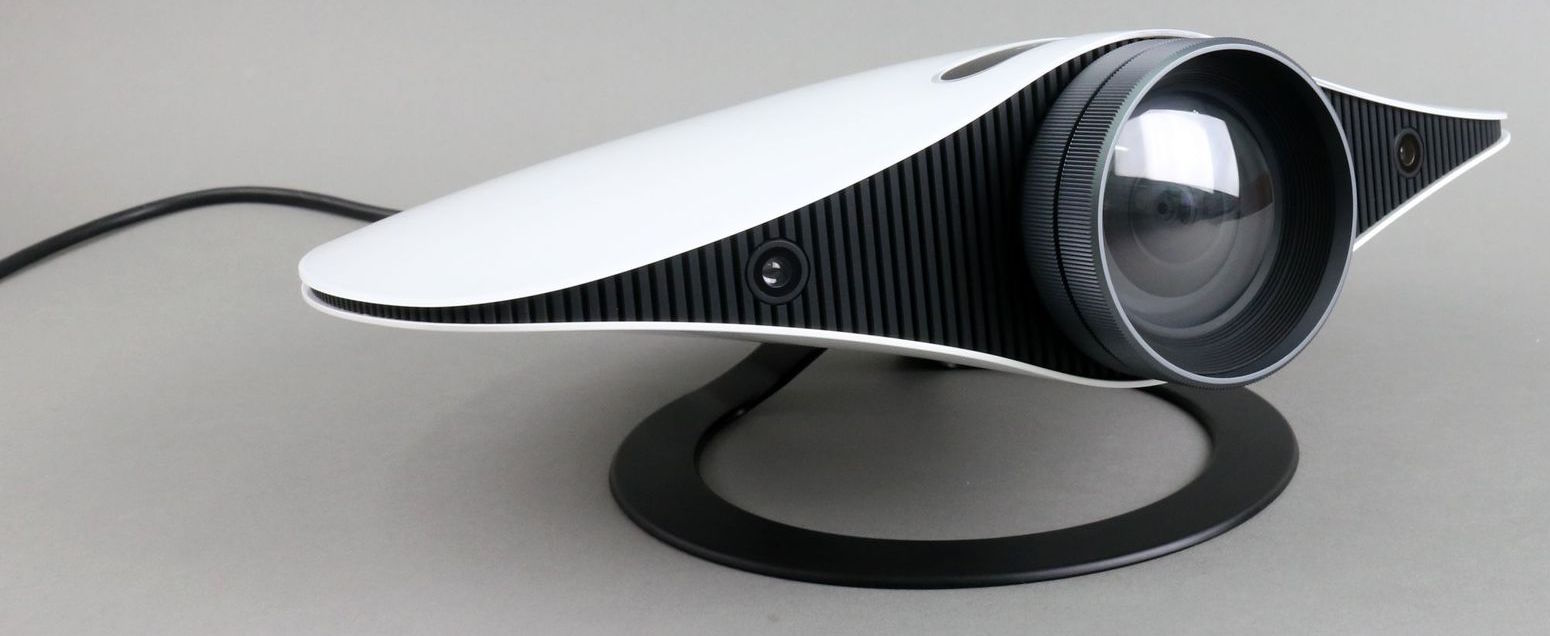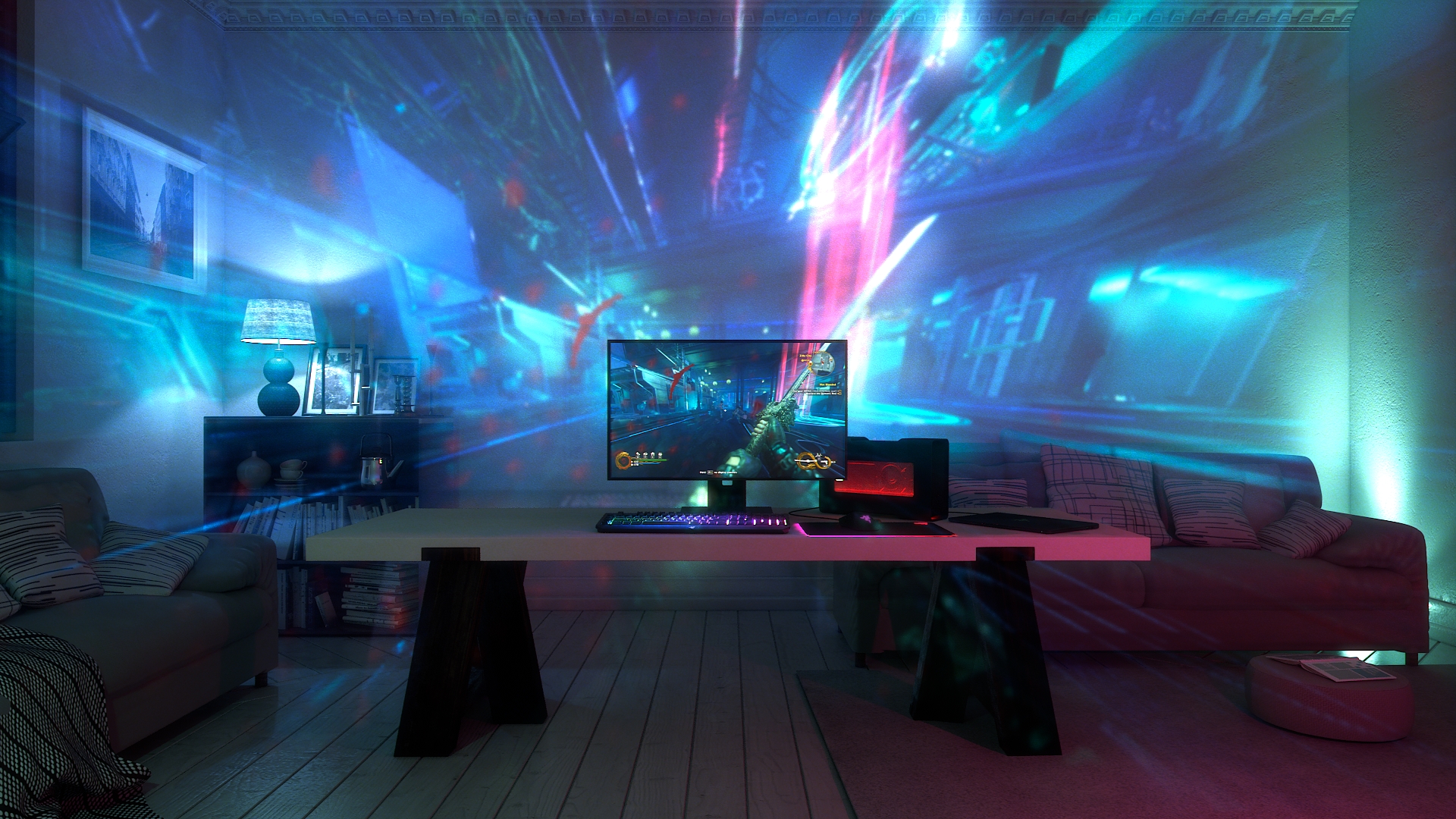Razer's Project Ariana Projector, Hands On
Project Valerie might have been Razer’s most highlighted product at CES, but the company also had another ambitious protoype to reveal at the show. Project Ariana is a projector that’s supposed to enhance your gaming experience by extending your field of view beyond the boundaries of the conventional screen. Razer sees it as the next evolution of its Chroma lighting technology, but based on the demo we saw, it’s something that might not capture everyone’s attention.
What We Know About The Hardware And How It Works
What we know so far about the internals of Project Ariana is that it features a fisheye lens (with a 155-degree field of view), two depth-sensing cameras, and a DisplayPort passthrough to work with your PC. We tried to get more specifics on the hardware, but Razer was mum on the subject. The company does have experience with depth-sensing cameras, specifically with its Stargazer webcam, which featured the SR300 model of Intel’s RealSense camera. However, it’s not clear if the same camera model is used for Project Ariana.
According to Kushal Tandon, Razer’s Chroma Marketing Manager, Ariana works by finding the screen and its relative position to the wall. Once the screen’s borders are recognized, the projector will then work with your regular game screen by displaying the game’s peripheral view that you wouldn’t otherwise see in a traditional setting. Depending on the size of the wall you’re using for the projector, you can also adjust the field of view so that it doesn’t extend past the corners.
A Wall Monitor
The result is something sort of like what you would see from a curved monitor, but at an extreme angle. With Shadow Warrior 2 (a first-person action game), most of the action occurred on the main screen. However, Project Ariana showed the game’s periphery view on the wall, which is designed to increase your immersion during gameplay.
The reason for the extreme angle at which the projector displays the game is because it’s supposed to emulate your eyes, which are directly focused on the screen. Ariana, then, provides a tunnel-vision effect that lets you see what’s going on around your character while you continue to look at the main display to play the game. In addition to the projector, the demo room also featured Philips’ Hue lighting, which works with Chroma to add even more color to the experience.
However, it all seemed a bit too much. The combination of Ariana plus the constantly changing ambient lighting made the room feel more like a nightclub than something I’d prefer for a gaming setup (although you don’t have to install the Hue lighting feature in your house in order to use Ariana). The tunnel vision effect of the projector wasn’t attractive either. It looked like you could get dizzy after using it for long periods of time, although it does somewhat help that the images displayed by Ariana are a bit blurry so as to not distract you from the main screen.
From Prototype To Reality
Tandon believes that Ariana will become an actual consumer device, and the company aims to launch it by the end of the year. For now, Razer is looking for feedback on what it can do to improve the projector.
Get Tom's Hardware's best news and in-depth reviews, straight to your inbox.
Even with the seemingly interesting hardware packed inside Project Ariana, the unknown factor with any new device is demand. With our attention already heavily focused on the monitor, what use is a projector? It might light up the room with your gameplay along with some flashy colors, but it doesn’t seem to provide any benefits to the actual gaming experience. We’ll see if Razer continues to demo it throughout the year at shows such as GDC and E3.
Rexly Peñaflorida is a freelance writer for Tom's Hardware covering topics such as computer hardware, video games, and general technology news.
-
Jeff Fx The technology is cool, mapping the room and warping the projected image to create an immersive scene is impressive, but isn't there a massive performance hit in rendering this much larger view? Most gamers want their video card to maximize detail and frame rate on the screen in front of them. I'd think adoption of this would be low if they were giving them away. How much do they expect to sell them for?Reply -
zodiacfml Overkill. I'd rather have those LED lights behind a monitor which can do the same thing. This projector would also require some distance to the wall which rarely of us have.Reply -
blackbit75 That is why we don't need 4K displays. I bet no one can find if a pixel es on or off in the image with movement in a game and such a distance. 1080p is more than enough.Reply -
razor512 Reply19154991 said:Um, can anyone say "Illumiroom"?
https://www.youtube.com/watch?v=Bhvm6tYUrgY
For such an old product, it is interesting to see it do a far better job than Project Ariana.
I would like something like that for use with a cheap $100 projector for simply displaying basic stats on the wall around the display. -
waynes This is the same sort of warp mapping projection technology I was planning to introduce on my game system design from last decade. It looks like they are missing a lot, and haven't done it anywhere near as well.Reply
Where is the soevs fur resolution, lumen, color space, the important thing. When you ate dealing with such projection it pays to get as close to 200% color as possible to compensate, and enliven things. A rec2020 100% color soave, maybe by quantum dit light source, is a good start.
For resolution, whatever desired resolution on a good feild of view is sy least 3x more over 180 degrees. So, that is at least fullhd x3, or 6k, 4k will be a bit grsiny. But 4kx3 will give a smoother picture to those with good eyesight, and 8kx3 the limit of this type of human vision.
If one can see well enough, and uses the center fraction of the eye they can see a 8k pixel. The rest of us just see less. The human eye works by glivking around a scene taking shd samples svene, snd you actually derive pleasure for the contrasty textures sampled this way, wherever the realise what is giving you the pleasure or not, or even notice it. It is the same with many so-called intangible elements of vision. In the film industry you can see things are set at just a certain way to increase audience enjoyment. In action games it is a different set though, as people are not being relaxed so much, and is more participatory hdr. So, with the right brightness a 8k pixel will stick out during sampling.
Wayne Morellini -
sillynilly Mmmm, not so convinced from the pics, video. I will need to use it to see if I like it. The idea seems ok, but I don't game on a large TV now since I don't like having to keep moving my head to see what is going on. I understand that the main action will remain on the monitor, so I am not sure how or why the expansion - blasted onto an uneven, painted, etc. wall will be a benefit to me? Dunno. Want to see it in person before I say ya or nay.Reply

